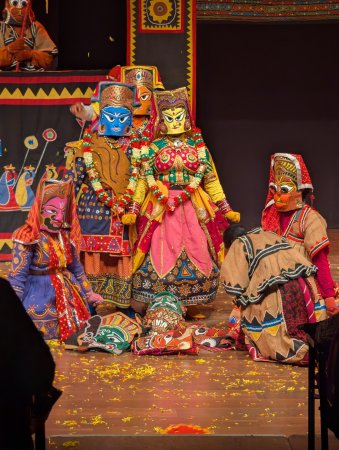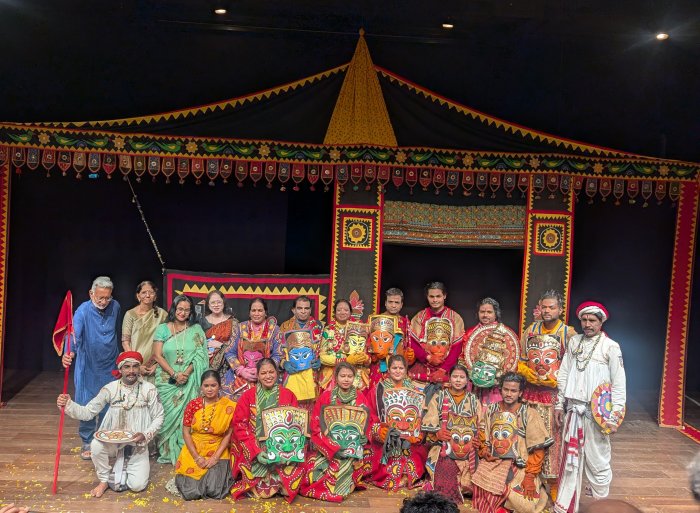
|   |

|   |
792 performances and still going strong: A timeless Ramayana like never before - Srinidhi Mohan e-mail: srinidhi.mohan30@gmail.com Photos: Srinidhi Mohan May 29, 2025 On the 10th of April 2025, I witnessed something truly unforgettable, a heritage production of the Ramayana that has been performed 792 times and still feels as fresh and powerful as ever. Titled as a UNESCO Heritage Production, this version of Ramayana is nothing like the typical retellings I've seen before. It brought alive the epic with real human puppets, hand-crafted jute costumes, and a production aesthetic that has remained untouched for over 74 years. This performance took place at NCPA as part of the Mudra Festival, and what a spectacular celebration of tradition it was. Introduced lovingly by Nirupama, she transported us to the humble beginnings of this epic production, a terrace in Bhulabhai School in 1952, where the very first performance took place. Since then, this incredible work has travelled across 36 countries, and yet, the soul of the piece, its design, choreography, costumes, and masks, remains completely intact. What stood out for me most was the commitment to authenticity. The sets designed by Hasan Premani are still the same, made entirely by hand on jute, even the costumes were crafted from ganny bags sourced from party offices back in the day! Can you imagine that? And the masks, yes, they are still the original ones made from thick Soviet-era magazine paper, now about 75 years old, but they've aged like fine art. It was stunning to see the preserved vibrancy of the colors and the detail in the craftsmanship.  It's not just the visuals that left me awestruck. The story behind this production moved me deeply. The original choreographer, Shanti Bardhan, created this Ramayana while battling tuberculosis, paralysis, and having lost six ribs. But even then, his passion for the art burned strong. Apparently, he wasn't fully happy with the abhinaya of the actors and jokingly said he wanted "good looking guys," which eventually inspired the idea of using puppets! His vision led to two iconic productions - Panchatantra and Ramayana. Panchatantra, interestingly, was born after observing birds under a banyan tree! Unfortunately, Bardhan passed away in 1954 at just 34 years old, but what a legacy he left behind. This Ramayana was a beautiful dance drama that slowly unfolded. What really struck one was how cleverly the story began, no sudden jump into puppetry. The first ten minutes were set in a village fair, with vibrant scenes of villagers enjoying themselves. A Puppet Master appears, inviting the crowd to "Dekho khel mera," a song so catchy and charismatic that the villagers began to mimic puppets. This is how the transformation began: ordinary people, drawn into the enchantment of storytelling, slowly turning into puppets themselves. Before the main story began, the company did something incredibly thoughtful and charming. Each character was introduced to us with handmade giant puppets being brought on stage, helping the audience visually identify and connect with Ram, Sita, Lakshman, Ravan, Hanuman, and others. It was like opening a living storybook where the pages walked right in front of you. From there, the epic tale unfolded seamlessly on stage. The coronation of Rama and Sita was performed by dancers dressed as puppets, who moved with such stylized grace that it truly felt like puppetry brought to life. The narrative moved through their departure for Vanvas, their boat ride across the Ganga, and the building of their humble forest dwelling. Surpanakha's entry added an eerie yet comical twist, followed by battles with rakshasas, and sweet, fleeting moments of joy shared by Ram, Sita, and Lakshman in the forest. The tone darkened with Ravan's dramatic entry and Surpanakha's vengeful complaint, leading to the golden deer episode where Maarich tricks Ram. The abduction of Sita by Ravan in the disguise of a sadhu was haunting, and the emotional high point came with the fight of Jatayu, who bravely tried to save her. Ram's meeting with Sugreev and Hanuman brought renewed energy, and the scene shifted to Lanka, where Hanuman found Sita in captivity. The act of Hanuman burning Lanka was full of fire and emotion, so powerful and dramatic that the audience broke into spontaneous applause. The story continued with grace and fluidity, culminating in the emotional reunion of Ram and Sita. It was tender and moving, not overplayed, but soaked in quiet dignity, much like the rest of the production. The final scenes brought the tale to its satisfying end, not with grand spectacle, but with a sense of emotional resolution that lingered long after the curtain call.  Puppet Ramayana team I was completely fascinated throughout by how committed the performers were to staying in character; they moved like actual puppets from start to finish, never slipping for even a moment. Their stylised gait, fixed expressions, and carefully modulated gestures created a believable illusion of marionettes under an unseen string. And just when I thought I couldn't be more charmed, we found out at the end that the artistes playing Ram and Sita are a real-life husband and wife. That just added another layer of magic to the entire experience. I've seen many versions of the Ramayana - classical, contemporary, minimalistic, dramatic, but never something like this. A living legacy performed with the same jute sets and masks for nearly eight decades, carried forward with such dedication and reverence. It wasn't just a performance; it was like being a part of history. This production didn't just tell the Ramayana. It lived it. And now, as they inch closer to their 1000th performance, I feel incredibly lucky to have witnessed the 792nd. Here's to heritage that breathes, art that endures, and stories that never lose their soul.  Srinidhi Mohan is an Odissi dancer trained under Nivedita Mukherjee at Aratrika Institute of Performing Arts. She holds a Visharad degree from Gandharva Mahavidyalaya. A curator with The Taal Tribe, she also mentors young dancers and choreographs classical and semi-classical pieces. Srinidhi is a passionate blogger who writes about dance, culture, and her artistic journey. |